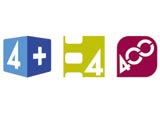Seeing off the bigger pitch
RTE’s 21-way unpaid pitch to rebrand its youth content has rekindled discontent in broadcast design over the issue, says Sarah Balmond

It’s crunch time for the broadcast design industry, with the revelation that Radio Telefis Éireann, the Irish public broadcaster, is holding a 21-way unpaid pitch to rebrand its young people’s programming output, called The Den (DW 2 June).
The issue of free pitching has always been a contentious issue across the sector, but the RTE pitch has caused particular concern among the broadcast design tranche because of its scope and scale. Designers are expressing outrage and are taking steps – signifying the first real concerted effort in years – to shake up the pitching process and put a stop to this practice.
A series of behind-closed-doors meetings is taking place involving some of the UK’s biggest players in the broadcast industry, including Kemistry, English & Pockett, Bruce Dunlop Associates, Dunning Eley Jones, Lambie-Nairn and Tag. The battle lines are being drawn up over tea and biscuits, and the group is expected to unveil a joint statement imminently.
The document’s articulation, form and impact are still being worked out and the stakes couldn’t be higher. For while the packaging sector has slowly managed to reverse the trend for unpaid pitches through lobbying, the broadcast industry has been slower on the uptake. Argument must now be matched with action.
‘A lot of pitches are paid but there’s a general unhappiness at unpaid pitches, which are damaging to our industry. There should be some ground rules put into place,’ says Graham McCallum, creative director at Kemistry.
The RTE project is a substantial one. It forms part of an overall strategy to reconfigure and boost childrens’ programming across pre-school, pre-teen and teen strands, and is the first rebrand in more than a decade. An in-house team designed the existing identity in 1996.
The broadcaster expects to select a consultancy within the month and is planning on inviting ‘five major contenders’ back to Ireland to pitch a winning creative shortly. Sheila de Courcy, commissioning editor for Young People’s RTE Television, is overseeing the initiative.
‘We’re looking for a very contemporary looking brand to work alongside different media, such as on-line, as well as merchandise. It must have applications across groups and genres,’ she says.
While the project is likely to throw up innovative work, the costs of participating in a pitch of this scale, bearing in mind the overheads of flights, accommodation and labour, is a weighty one. Already one American consultancy has withdrawn from the pitch and it will not be surprising if others follow suit.
‘We’ve had an overwhelming response and were surprised so many expressed interest, but this is a prestigious project,’ says Jim Booth, head of promotions at RTE Television.
He insists that although it may be quite expensive for consultancies to work up a pitch, ‘we can’t get into the situation of paying’. Booth argues that costs can be covered by wins, pragmatically stating that the free pitch is the design industry’s ‘raison d’être’.
English & Pockett did not pitch for the RTE project after carrying out a risk analysis procedure and deciding against submitting a proposal. However, the consultancy is participating in a number of other undisclosed non-fee pitches, says managing director Richard Wallman.
‘You can’t force clients to pay and you can always walk away,’ he says. ‘If a job is worth a pitch fee, we’ll say so. Pitching goes through peaks and troughs according to supply and demand – it’s market-driven.’
However, Wallman does discourage the type of mass pitch as exemplified by RTE. ‘There’ll be a lot of losers who could better spend their time and resources,’ he says.
Wallman suggests various initiatives, speculating on the possibility of developing a working document or guidelines to create a standard working practice. He also thinks broadcasters should enlighten consultancies about the details of the pitch to give them the chance for reappraisal.
Dunning Eley Jones partner Liz Dunning also calls for similar action. She believes consultancies should take the lessons learned by the packaging industry and apply them to broadcast design.
‘The industry should insist on getting paid for creative pitches, which will naturally bring the numbers down, or if a client is unprepared to pay, insist it is credentials only,’ she argues. ‘The situation has become worse recently as traditionally lists were between three and five companies at most; lately the trend is upward.’
For the time being, those involved in the round-table meetings are keeping tight-lipped about the specific details of what they hope will emerge. While their efforts are commendable, it must be matched by client willingness to meet them halfway, if they are to reverse the long-standing trend for free creative pitching.
If this happens, then a historic change could be afoot that will change the face of pitching forever.
The DBA view
The DBA Code of Conduct recommends that ‘members should take part in pitches which require unpaid work. The level of payment should relate to the time and effort involved.’
Screen design pitches
• Unpaid pitches have steadily grown over the years in the broadcast design sector
• The number of creative groups typically invited to pitch has risen from between three and five to sometimes double figures
-
Post a comment




